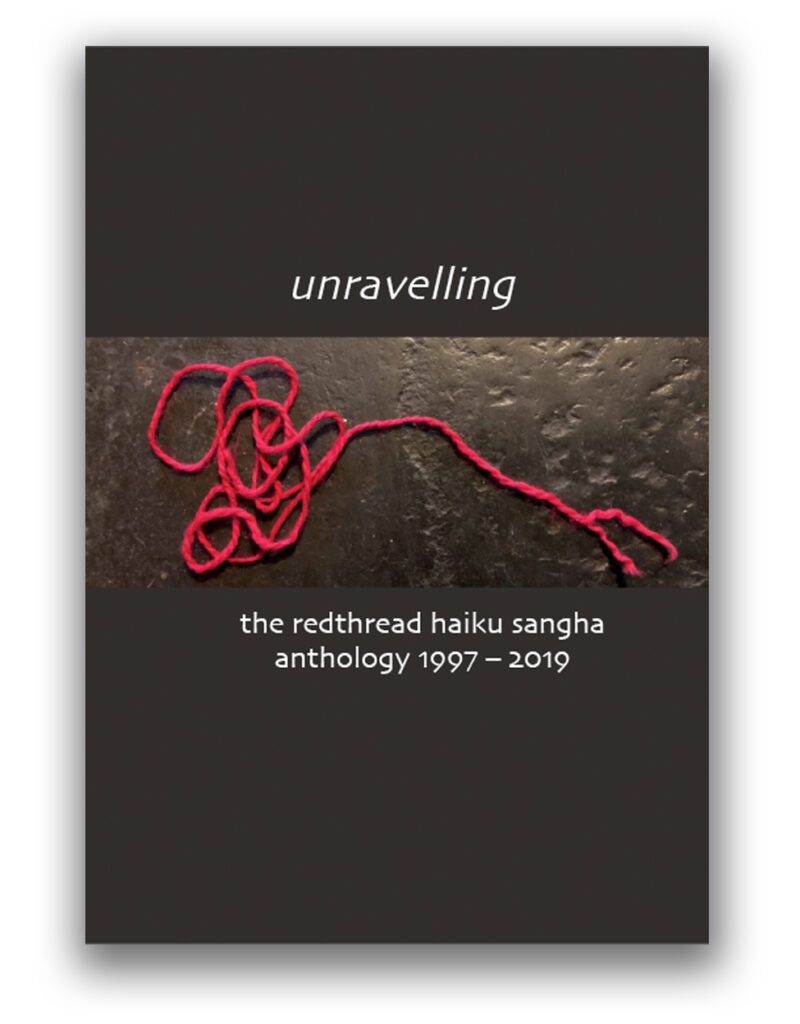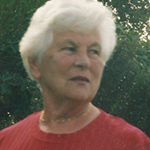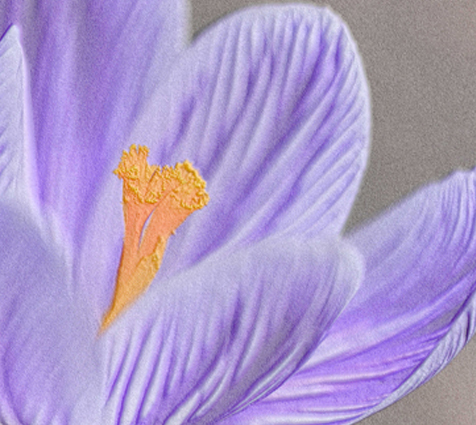
Book Review: unravelling
the redthread haiku sangha anthology 1997-2019
Edited by James Norton Published by Alba Publishing Uxbridge, UK 2019, Paperback, 76 pp. ISBN: 978-1-912773-29-9 £12 Ordering Information
Reviewed by Patricia Prime
unravelling is a triumph. Brought together in this volume are haiku and haibun written by a group of poets, the “redthread” sangha, who practice both genres and have a gift for funny, moving, unflinching verses. Since 1996, these poets have met annually for a retreat – first in Ireland and then, for the past two decades, in Wales. There they’ve practiced the inner path of spirituality and its expression in haiku and haibun. They encourage one another “to write and read those haiku which have a resonance beyond the descriptive, an “existential aftertaste” and ”to offer a liberative vision of haiku as an everyday spirituality beyond sectarian divides.”
This anthology of their work ranges from 1997-2019 and includes the work of 17 members who have been part of the group at one time or another. An example from each will show the range and quality of their work.
Jonathan Buckley practices zazen and earns a living as a cycle instructor, business writer, and communicator. His haiku are minimalist:
sit chin on hand boulder on beach
His haibun “The Autumn of My Days” takes place in an old farm house, where several people are gathered:
- Later that evening in the snug of the old farm house someone suggests that paintings of rice cakes can nourish. A definition of haiku is shared: the poetry of bent nails. And when I look for my pencil someone kindly asks me what I have lost . . .
Heather Dyer, who also writes children’s fiction and teaches creative and academic writing, offers one page of haiku. It begins with the following poem:
noon
inside a foxglove
the soft clatter of a bumble bee
Megan Griffiths was introduced to the delight of reading and writing haiku by Ken Jones, a founding member of redthread (see below). Her selection was written and inspired by being in the Welsh farm house where the redthread poets gather for their annual retreat. An example of her haiku:
a still dawning
one candle lighting the greyness
these veined hands
Her haibun “unspoken” focuses on her father, a Welshman living in England. The haibun ends:
- Evenings the gathering round the range.
in weary silence
nodding together
another day westered
- Belying earthly impoverishment, under shiny black marble they now lie.
Ken Jones (1930-2015) was a Zen practioner, peace activist, and author. He often focused on simple things in haiku:
in the dawn light
at the foot of the bead
her worn shore
The subjects of his haibun are often the moors, bogs and natural scenery of the Welsh countryside. His haibun “The Question” begins:
Skyline far off the fretted gate always there
- As in some obsessive love affair, I am drawn back again and again. This lonely strip of water, now black, now silver, now Prussian blue. Here I sit and pace the shoreline, night and day.
Noragh Jones was Ken’s wife; she passed away a year after her husband’s death. She was a historian, author, and a fine writer of haiku and haibun writer. Her series of haiku, “Death Haiku – For Ken,” is a fitting memorial for her partner of many years. The first haiku reads:
his final year
she learns to love
the bones beneath the skin
Her haibun “By the Waters of the Rheidol,” with its reference to the biblical “Waters of Babylon,” is a paean to the memory of her husband:
- By the waters of the Rheidol I sat down and wept. Beached on this boundary shore I stare at nature’s bounty and find no solace. Heavy with the burden of memories, I arise and plod the edgelands between land and water. Stilled by the hardworn smoothness of river stones, I gather a handful to take back to my sad suburb. The solitude breaks when a family arrives with full complement of dogs and kids. Skimming stones they scream with delight when they hit the far bank. I pack up and flee for so much life is hard to bear. Hurling my half-gnawed apple core into the current, I watch it get stranded in a mini whirlpool, bobbing round and round in vain circles, going nowhere.
- I climb up the oak clad slopes and disappear into the green yonder.
a morning so still you can hear the silence
George Marsh was a teacher at schools, prisons, and three universities. His haiku have their own unique humour:
Before school
ten minutes in heaven
drawing devils
His haibun “Water” focuses on prison life. It begins:
- There’s a dead man on the Lifer wing. I left him there with my Lifer friends and came to gaze at the lake. The dripping dip of oars and complaints of a goose reach me across the still water from a mile away.
pale afternoon a grebe vanishes into the white mirror
Joe McFadden was the librarian for Haiku Spirit and a founding member of Haiku Ireland. His selection of haiku includes these poems:
In the field
with the ruined church—
wild garlic
Under wolf moon—
sweeping the floor
in the all night shop.
Jim Norton lives in Dublin, between the mountains and the sea, where he sketches and paints. Here’s one of his haiku:
over the rice porridge at the tip of a finger the morning star
His haibun “Out of the Blue” finds him hurrying through the streets to the shore where he senses a change in the air.
- Between the wasteland and the strand, drifting in a state dream-like but with senses heightened, feeling each droplet, turning about in wonder, out of insubstantiality forms manifest. Slabs of concrete bristling with rusty iron float Into view, dissolve. Dripping silver, a toothy stand of teasels cards the fleecy wraithes.
On the shoreline man and heron swallowed whole
Sean O’Connor is the founder and editor of The Haibun Journal. His haiku include:
silence
these weathered stones
speak
His haibun “moving” focuses on a journey made with a friend:
- One more visit to the meditation ground between house and hilly wood. Sodden shingle on the rise before wet grass, a line low with flattening footsteps. Between branches, faded prayer flags hang light, limp on lines thin and white, wavering slightly.
half dark
the stone Goddess
her open lap
Marian Partington lives in Montgomeryshire with her husband and four children. Her haiku reflect family and nature:
Around this corner
A surprise of daffodils
Strapped to a lamp post
Stuart Quine (1962-2020) practiced Soto Zen Buddhism. His haiku are one-liners. They include
muffled steeple bells snowfall on a northern town
His haibun “At the Sento” begins:
- With bellies full of okonimyaki we dash through the rain and push through the noren into the foyer of a backstreet sento. shoes, zori, children’s rubber boots, a rain-wet-bicycle and two doors bearing the kanji for ‘Men’ and ‘Women’.
The haibun ends with this one-line haiku:
moonlight on old tatami tonight I will dream
Kim Richardson is the editor of Alba Publishing and has published two collections: Double Rainbow (2005), with Maeve O’Sullivan, and a solo collection, Night Ferry (2018). His haiku includes
after morning practice
a butterfly's wing
—all there is
Kim’s haibun “Learning to Ride a Bicycle” reflects his childhood:
- My father’s voice carries across the distance between us. I look over my shoulder to see he had let go of the bicycle a hundred yards ago. Elated, I wobble and almost fall, but catch my balance again and push down on the little pedals, taking off down the gravel path.
ducks floating on sky a shimmer of clouds
Karen Robbie lives in Wales and is a Zen practitioner. Her minimalist haiku include:
slow walking
tracing the waves
with my hand
In her haibun “Red Sorrel” she writes:
- I put on wellies and waterproofs and set out in the rain. The roadside is thick with buttercup and red clover. Towards the reservoir my eyes catch waves o red sorrel. Six goslings appear in the water.
- They’ve grown big since I last saw them. Last year only one survived. I don’t go far and return after my count. Climb the gate and gather the scent of yellow in the afternoon sun.
reddening sky
songs
on a telegraph wire
Jane Spray runs a Chan meditation group in the Forest of Dean. She writes:
searching for mushrooms
everything looks
like a mushroom
Her haibun “Emotional Awareness Retreat” focuses on a retreat led by Ken Jones in Maenllwyd: “In the Chan Hall, Ken soon has us enquiring, one to another, ‘tell me how it feels, tell me how it feels’. The tissue box is out.”
Jane Whittle lives in rural Wales where the members of the redthread sangha gather for meetings. One of her haiku is simply put:
first up
the lark invisible
as I am
The haibun “Mountains and Rivers” is one of the more lengthier haibun in the book. It is about a stay in a concrete shack in the mountains, where
- We seem to have chosen the wettest weekend of the summer—the walls and floors are running with water. Night falls early and the moon is soon wiped from the sky.
Bill Wyatt was the first ordained Zen monk in the United Kingdom. He sustained his Zen practice until his death in 2016. His haiku are humorous:
Morning zazen –
rain on the rooftops – in one ear
& out the other
His haibun “Dream Haibun—Bread and Honey” is one lengthy paragraph followed by a haiku. It begins:
- I’m in what appears to be a hippy commune—people hustling and bustling about—the floor, big red brick slabs, reminds me of the old cow barn at Throssel Hole Priory before we took It over and converted it to the eating and study quarters.
It ends on a reflective note:
Bread and honey so elusive – like that dream of first love
The collection concludes with a list of contributors and four appendices: “Starting The Thread,” “Joy & Grief: One Brush,” a haiku workshop by Ken Jones, “Haiku & Zen” (George Marsh), and “Chiyo,” a story about the famed Japanese poet Chiyo-ni (1703-75) and her “haiku awakening” while writing about a cuckoo. The last article is from Zen and Japanese Culture by D.T. Suzuki; originally published in 1959, it presents this awakening as a true story, although later scholars have noted that it appears apocryphal (but still entertaining and influential).
These intense, personal, and spontaneous haiku and haibun have the lyrical imagination that make the poems a lively read. With humour, love for nature, deep insight, philosophical profundity and humanity, they express honest and emotive responses to the poets’ varied journeys through life.
About the Reviewer

Patricia Prime is co-editor of the NZ haiku journal Kokako. She is the articles editor for Contemporary Haibun Online and also is a reviewer for Atlas Poetica, Takahe, and other journals.
